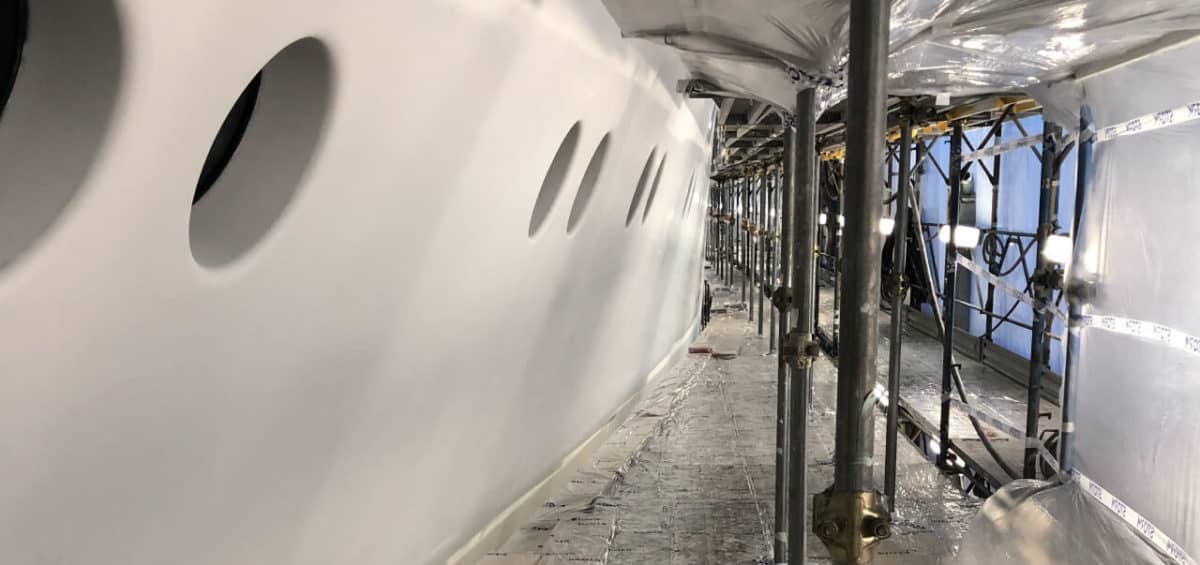How hard does a ship’s outer surfaces really have to work?
Whether they are small launches, fishing vessels, commercial ships, or superyachts, ships of all types lead rugged lives – both when lying at anchor and when plying the busy shipping lanes. Their outer surfaces endure constant saturation and drying from salt water, and long periods of temperature extremes ranging from blistering hot sunlight to sub-zero conditions that encrust them with ice.
These external surfaces also need to sustain frequent direct impacts and chafing from multiple solid objects, including attack at times from sea creatures. And they must tolerate the massive stresses and strains transmitted to them through the vessel’s structure from carrying full cargos and being tossed by mountainous waves. Here they are assailed by forces of hundreds of tonnes per metre.
In all this, a ship’s paintwork and coatings are a crucial line of defence. Unless they are applied and maintained carefully, using quality driven procedures – the boat’s lifespan will dramatically decrease. The materials used for its construction will only perform as required if they are adequately protected from the hostile environment which constantly surrounds them.
Furthermore, consider superyachts and luxury vessels for a moment. Here the outer coatings must not only give the vessels their full protection, but also maintain an impeccable appearance for long periods of time. Many of the largest megayachts that roam the sea are owned privately, such extravagant ships are often requisitioned for some of the world’s wealthiest individuals, and regarded as their status symbols.
No wonder that yacht builders invest a lot of time and money into these coating and painting processes. Those who gain a consistent reputation for excellence, occupy pole position for large repeat orders from their satisfied clients.
Maintaining these luxury vessels is also a costly operation. Many superyachts require re-painting around every 5 years, and the amount of work involved can incur 6 or 7-figure costs.
Will it Benefit to Cut My Yacht Surface Protection Material Costs?
Yacht-building and refurbishing are a competitive business. New competitors are easily drawn to such a successful industry sector, and as a result prices can increasingly come under pressure. This leaves yacht builders looking to drive costs down wherever possible in their operations.
Significant quantities of surface protection material are used in the production and renovation of luxury vessels, and the cost of this can be appreciable. Therefore, reducing this cost can appear to be a logical approach to project management.
Various cost-cutting approaches can be evaluated – reducing the quantities used, using lower specifications or thinner material, covering less of the vulnerable surfaces, and reusing more material. However, although this can provide some short-term cost reductions, these are often followed by unexpected extra costs which are even higher than before.
There are viable and productive ways for builders and contractors to cut costs without sacrificing the quality of their work, see our article on how to cut tenting time by 50%.
The Consequences of Cutting Surface Material Costs
Proposals for cutting corners on your surface protection must be considered very carefully. If carried out incorrectly, they can lead to huge reworking costs further down the line. Failing to use correctly specified surface protection may ultimately cost you more in time, money and reputation.
Here are some of the unforeseen problems that can occur:
- Damage from workers and visitors.
- Damage from work/access equipment.
- Foot erosion, scratches, chips, dents and scuffs.
- Existing or previously finished parts needing to be replaced or refinished.
- Wet paint and other substances being spread into other areas. Also dripping/running onto finished surfaces.
- Overspray of paint and other coatings onto other areas. Also, onto scaffold and work equipment.
- Damage to sensitive and expensive instrumentation or working parts.
- Chemicals leaking through inadequate or thinner materials.
- Protective material adhering to surfaces due to chemical leaching.
- Incorrectly specified protection materials leaving a residue when removed. This can require both removal of the residue and refinishing of the surface.
- Drastic reduction of service life of paints and coatings due to dust ingress during the application and curing processes.
- Health and safety implications due to work environments and adjoining areas becoming slippery or at risk of fire. Extra hazards when working at height.
- Occupational health risks due to inadequate containment of substances and vapours. Unintended skin contact with hazardous chemicals.
Solutions
Seek skilled advice.
Satisfactory suppliers of surface protection materials will be able to tell you exactly where each of their products will work – anywhere in your operation.
Better suppliers will be able to help you with tips or practical cost comparisons, to guide you towards making cost savings.
And world-class suppliers will have the experience and commitment to stand alongside you, seeing your situation through your eyes. They will feel your pain, and share the elation you experience in reaching the perfect solutions for your operation. Here you will benefit from not only the cost savings you make – but also solutions for your most painful problems. And complete peace of mind.
See how Fendwrap can become your partner of choice for protection materials and solutions.



